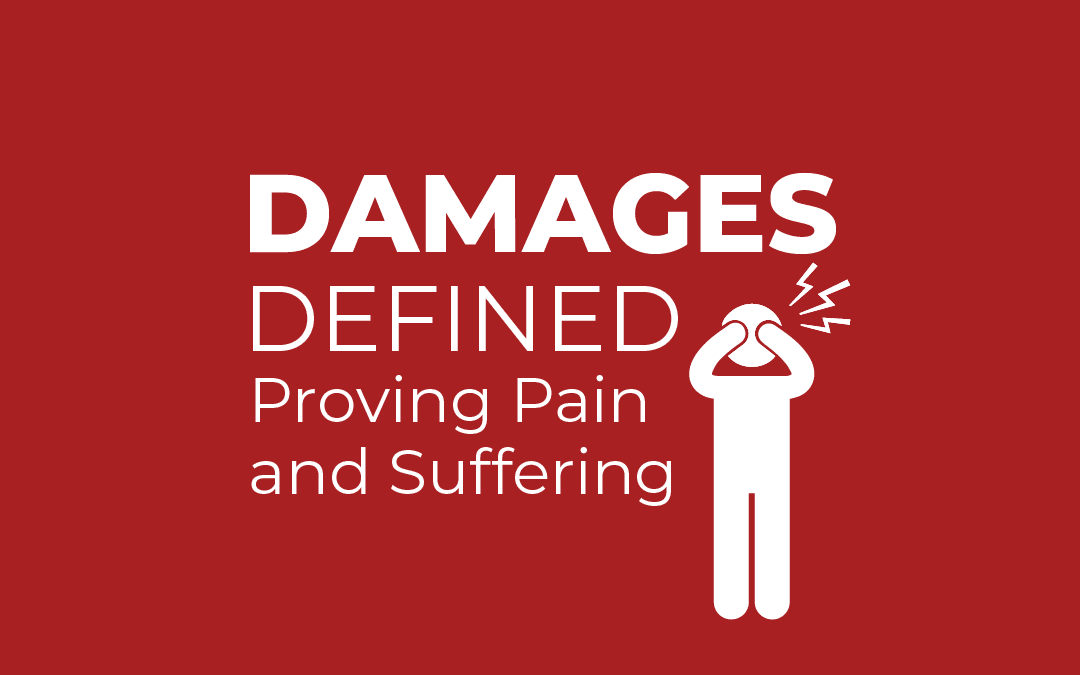Can You Sue For Pain and Suffering?

Car accidents can happen to anyone, at any time, and often when we least expect them. If you’ve been involved in a car crash in Albuquerque, New Mexico, you may choose to file a personal injury claim. When doing so, you’ll likely hear the word “damages” used when discussing your losses and accrued expenses – but what do damages actually encompass? You may also hear the phrase “pain and suffering”, and where does that come into play? Calculating the damages, pain, and suffering you are owed due to the incident are both crucial aspects of personal injury claims. However, this process can be far from straightforward. In this blog, we’ll discuss the different types of damages that are evaluated in a personal injury case. We’ll also explore how to establish and be rewarded pain and suffering after an accident, how pain and suffering calculated, and how the experienced Albuquerque car accident lawyers at Ron Bell Injury Lawyers can help you obtain the highest possible compensation for the damages you are owed.
What are Damages?
Damages are the award that is given to an injured victim to compensate them for harm caused by another party. They are typically monetary in value. Put simply, damages are the money you’re given to make up for someone else’s wrongdoing.
There are two types of damages: compensatory damages and punitive damages.
Compensatory damages
These are awarded to the injured party based on their losses experienced during the incident and to provide them justice. There are two types of compensatory damages: actual and general. Actual compensatory damages account for the monetary amount that was lost due to the incident, which may include medical expenses, property damage, and lost wages. General compensatory damages pertain to those non-monetary losses sustained from the incident, including (but not limited to) your pain and suffering, future loss of wages and expenses, and loss of consortium.
Punitive damages
Punitive damages, on the other hand, are meant to discourage the negligent party from continuing harmful behavior that could hurt others. They are essentially a form of punishment for dangerous behavior that also benefits the injured victim. However, awards for punitive damage in car accident cases are rare and can be difficult to prove. For car wreck injuries, compensatory damages are the primary focus.
Pain and Suffering: The Basics
Pain and suffering damages fall under the umbrella of compensatory damages. It is intended to reimburse accident victims for the physical and emotional distress they’ve endured as a result of the accident. These damages go beyond the tangible economic losses (medical bills, property damage, lost wages). Rather, they exist to provide compensation for a victim’s more intangible losses, which can include trauma, discomfort, stress, and the loss of enjoyment of life. A victim of a catastrophic car accident may suffer from anxiety following the collision. Someone with a lifelong injury may no longer be able to enjoy hobbies or physical activities they once loved due to their disability. While these damages are more difficult to put a number to than medical bills or lost wages, they’re still critical to a personal injury case and play a significant role in a victim’s life and the amount of compensation they can recover.
How is Pain and Suffering Calculated?
While pain and suffering is more difficult to calculate than something with a concrete number, like your medical bills or property damage, insurance companies use certain methods to determine what they will offer a car accident victim. A common technique used is the multiplier method, where the victim’s medical bills and other expenses will be added and multiplied between 1.5 – 5. The multiplier is determined by several factors, including the severity of injuries, the impact the injuries have had on the victim’s life, and their chance at a full recovery. For example, if someone is injured in a car accident in Albuquerque and loses their leg in the process, the long-term consequences for that person are staggering. They will never fully recover or have the same quality of life they once had. In this example, if the individual accrues $200,000 in expenses, and they were given a multiplier of 4 for the extreme consequences the injury has had or would have on their life, they may be offered $800,000. However, supporting your claim with documented evidence is essential when negotiating with the insurance company.
How to Prove Pain and Suffering
There are a few steps you can take to help support your pain and suffering claim after a car crash in Albuquerque. Thankfully, they are the same steps you should take to strengthen your personal injury claim as a whole.
- Document Your Albuquerque Injury Case: One of the most important things you can do for your personal injury claim is to keep precise documentation throughout the entire process. From the moment of the collision to the time your case comes to an end, records and documentation are critical for maximizing your pain and suffering, and your claim overall. A few essential ways to document your experience are:
- File an Albuquerque car accident report. Contact the local authorities to report the accident. If your accident is in Albuquerque, you can call the Albuquerque police. If your collision is outside of Albuquerque, contact the local law enforcement branch or New Mexico State Police. If an officer does not respond to the scene, make sure to file a report on your own. An accident report will provide essential information about the conditions during the collision and can help determine fault. It is also a starting point for documenting injuries, which will factor into your pain and suffering.
- Take photos. As your body heals from the car accident, you will likely notice bruises, cuts, and scars change over time. If you are required to undergo surgery or other procedures, you will see even more obvious physical differences. These changes should be photographed, as they can show the stages of healing and better convey the pain you endured throughout the course of your treatment.
- Get consistent medical treatment. This means not only visiting the doctor but also following their treatment plan and coming back as scheduled for follow-up appointments. If you are prescribed physical therapy, attend all your scheduled appointments and avoid skipping treatment. Each time you visit a doctor or go to an appointment, your condition is noted in a medical chart. These documents are essential for proving the extent of your injuries and your pain and suffering. Proving your pain and suffering will be significantly more difficult without consistent treatment, especially in circumstances such as whiplash claims where injuries may not be visible.
- Keep a journal. Your own documentations are important for proving pain and suffering as well. Keep records of your medications, doctor visits, and overall experience. How are you feeling physically and emotionally in the aftermath of the collision? Do you have days that are better or worse? Are there situations that cause you anxiety or distress? Have you had any changes in mood, behavior, or sleeping patterns? Write it down. All of these topics are helpful for your healthcare providers in creating your treatment plan, as well.
- Be Open With Your Doctor: Open and honest communication with your doctors and health care providers is necessary for not only proving the extent of your pain and suffering but also for getting the best possible physical recovery following your collision. Be honest with your doctor. Tell them about everything that hurts, the ways that your injuries impact your life, and if their treatment plan is helping. Don’t exaggerate, but also don’t try to minimize the situation or downplay your own suffering. Additionally, if you’re experiencing stress, anxiety, or any other changes in mood or behavior, talk to your doctor about it. Talking about mental health can be challenging, but your emotional well-being following a car accident is just as important as your physical well-being. Your healthcare provider may refer you to a psychiatrist or recommend other forms of therapy to help you cope with the emotional trauma you have experienced. These will be documented in your medical records and further prove your pain and suffering.
- Keep In Touch with Your Lawyer: If you hire an attorney, make sure to keep them informed of any changes in your health condition, your health care provider, or your treatment plan. If you update your phone number, home address, or email address, you will need to notify your attorney of these changes as well. Your attorney and legal team will need to be kept updated and informed of any contact information and health changes to build the best possible case for your pain and suffering.
Albuquerque Pain and Suffering Lawyer
Negotiating with the insurance company can be a daunting task, and fighting for the pain and suffering compensation you deserve can require significant time, resources, and knowledge of injury law. Insurance companies will try to find ways to pay you as little as possible, including minimizing your pain and suffering claims. Don’t fall for their tricks! The team at Ron Bell Injury Lawyers has been advocating for the damages our clients deserve for over 40 years. We’re right here in Albuquerque, and we’re ready to take on the insurance company on your behalf so you can focus on getting better. If you’ve been hurt, we can help gather essential documentation, evidence, medical records, and more to maximize your pain and suffering claim and get the money you deserve. Get our experienced Albuquerque personal injury attorneys in your corner.
Ring the Bell! Call us today at 898-BELL for a free consultation.
Why Choose Ron Bell Injury Lawyers?
We Get Results!
